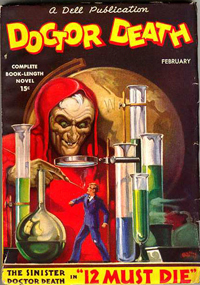
Doctor Death was the title of a short-lived pulp science fiction magazine published by Dell Magazines in 1935, as well as the name of the main character featured in that magazine. Doctor Death was an archcriminal who wanted to return the world to a primitive condition and used supernatural tools such as zombies and magic in his plots against humanity. The stories were written by Harold Ward under the pseudonym of "Zorro". Dell may have intended Doctor Death to be a continuation of a character of the same name in All Detective Magazine, also published by Dell.
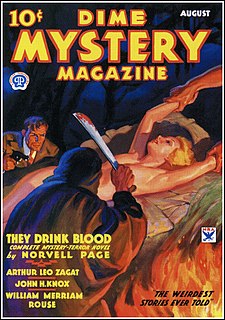
Weird menace is the name given to a subgenre of horror fiction and detective fiction that was popular in the pulp magazines of the 1930s and early 1940s. The weird menace pulps, also known as shudder pulps, generally featured stories in which the hero was pitted against sadistic villains, with graphic scenes of torture and brutality.
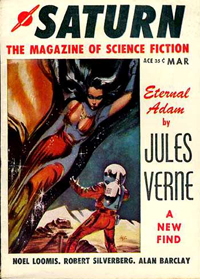
Saturn was an American magazine published from 1957 to 1965. It was launched as a science fiction magazine, but sales were weak, and after five issues the publisher, Robert C. Sproul, switched the magazine to hardboiled detective fiction that emphasized sex and sadism. Sproul retitled the magazine Saturn Web Detective Story Magazine to support the change, and shortened the title to Web Detective Stories the following year. In 1962, the title was changed yet again, this time to Web Terror Stories, and the contents became mostly weird menace tales—a genre in which apparently supernatural powers are revealed to have a logical explanation at the end of the story.

Avon published three related magazines in the late 1940s and early 1950s, titled Avon Fantasy Reader, Avon Science Fiction Reader, and Avon Science Fiction and Fantasy Reader. These were digest size magazines which reprinted science fiction and fantasy literature by now well-known authors. They were edited by Donald A. Wollheim and published by Avon.

Marvel Science Stories was an American pulp magazine that ran for a total of fifteen issues in two separate runs, both edited by Robert O. Erisman. The publisher for the first run was Postal Publications, and the second run was published by Western Publishing; both companies were owned by Abraham and Martin Goodman. The first issue was dated August 1938, and carried stories with more sexual content than was usual for the genre, including several stories by Henry Kuttner, under his own name and also under pseudonyms. Reaction was generally negative, with one reader referring to Kuttner's story "The Time Trap" as "trash". This was the first of several titles featuring the word "Marvel", and Marvel Comics came from the same stable in the following year.

Strange Tales was an American pulp magazine first published from 1931 to 1933 by Clayton Publications. It specialized in fantasy and weird fiction, and was a significant competitor to Weird Tales, the leading magazine in the field. Its published stories include "Wolves of Darkness" by Jack Williamson, as well as work by Robert E. Howard and Clark Ashton Smith. The magazine ceased publication when Clayton entered bankruptcy. It was temporarily revived by Wildside Press, which published three issues edited by Robert M. Price from 2003 to 2007.

Ghost Stories was an American pulp magazine that published 64 issues between 1926 and 1932. It was one of the earliest competitors to Weird Tales, the first magazine to specialize in the fantasy and occult fiction genre. It was a companion magazine to True Story and True Detective Stories, and focused almost entirely on stories about ghosts, many of which were written by staff writers but presented under pseudonyms as true confessions. These were often accompanied by faked photographs to make the stories appear more believable. Ghost Stories also had original and reprinted contributions, including works by Robert E. Howard, Carl Jacobi, and Frank Belknap Long. Among the reprints were Agatha Christie's "The Last Seance", several stories by H.G. Wells, and Charles Dickens's "The Signal-Man". Initially successful, the magazine began to lose readers and in 1930 was sold to Harold Hersey. Hersey was unable to reverse the magazine's decline, and publication of Ghost Stories ceased in early 1932.

Doc Savage was an American pulp magazine that was published from 1933 to 1949. Street & Smith already had a successful hero pulp, The Shadow, and were interested in adding another. They planned to create one called The Phantom, but when Standard Publications launched The Phantom Detective in early 1933 the character of Doc Savage was created instead. Each issue ran a lead novel. Most were written by Lester Dent, but there were four ghost-writers—Harold A. Davis, Ryerson Johnson, Laurence Donovan, and Alan Hathway—until 1941, after which Dent wrote all the lead stories until 1946, when Bogard and Davis returned. The novels almost always featured science fiction elements, such as a metal-destroying ray, a teleportation mechanism, or the ability to revive a dead person from history. Despite this, Street & Smith considered Doc Savage to be an adventure magazine, not a science fiction magazine, so the short stories that accompanied the lead novel were straightforward adventure fiction. Writers who frequently contributed these stories included Steve Fisher, Laurence Donovan, and William Bogart.

Science-fiction and fantasy magazines began to be published in the United States in the 1920s. Stories with science-fiction themes had been appearing for decades in pulp magazines such as Argosy, but there were no magazines that specialized in a single genre until 1915, when Street & Smith, one of the major pulp publishers, brought out Detective Story Magazine. The first magazine to focus solely on fantasy and horror was Weird Tales, which was launched in 1923, and established itself as the leading weird fiction magazine over the next two decades; writers such as H.P. Lovecraft, Clark Ashton Smith and Robert E. Howard became regular contributors. In 1926 Weird Tales was joined by Amazing Stories, published by Hugo Gernsback; Amazing printed only science fiction, and no fantasy. Gernsback included a letter column in Amazing Stories, and this led to the creation of organized science-fiction fandom, as fans contacted each other using the addresses published with the letters. Gernsback wanted the fiction he printed to be scientifically accurate, and educational, as well as entertaining, but found it difficult to obtain stories that met his goals; he printed "The Moon Pool" by Abraham Merritt in 1927, despite it being completely unscientific. Gernsback lost control of Amazing Stories in 1929, but quickly started several new magazines. Wonder Stories, one of Gernsback's titles, was edited by David Lasser, who worked to improve the quality of the fiction he received. Another early competitor was Astounding Stories of Super-Science, which appeared in 1930, edited by Harry Bates, but Bates printed only the most basic adventure stories with minimal scientific content, and little of the material from his era is now remembered.

Suspense Magazine was a fiction magazine which published four issues in 1951 and 1952. The editor was Theodore Irwin. The magazine included science fiction, fantasy, mystery, and weird fiction. Many of the stories were reprints, including science fiction from A.E. van Vogt, Ray Bradbury, and Theodore Sturgeon, and fantasy by William Hope Hodgson, Ambrose Bierce, and Arthur Quiller-Couch. The Fall 1951 issue included Fritz Leiber's "Dark Vengeance", a story in his Fafhrd and the Gray Mouser series.

Captain Hazzard was a science fiction pulp magazine which published one issue in 1938. It was published by Aaron Wyn's Ace Magazines, and edited by Aaron's wife, Rose Wyn. The lead novel, "Python-Men of the Lost City", featured Captain Hazzard, a telepathic superhero; the author's name, "Chester Hawks", was a pseudonym. The magazine also contained some shorter fiction. The lead novel was reprinted in 1974 by Robert Weinberg.
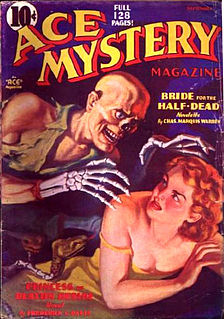
Ace Mystery was a weird menace pulp magazine which published three issues starting 1936, followed by two more under the title Detective Romances. It was published by Periodical House and edited by Harry Widmer. Writers who appeared in the magazine included Frederick C. Davis, who wrote all three lead novels, Hugh B. Cave, and Robert C. Blackmon; magazine historian Michael Cook comments that these were capable writers, but the rest of the magazine was too low-quality to succeed. Some of the stories were fantasy rather than weird menace -- for example, one story was about a sculptor who could shrink dead bodies. Science fiction historian Mike Ashley is more positive than Cook, describing the magazine as "of reasonably good quality", and singling out Charles Marquis Warren's "Coyote Woman" for praise; Ashley quotes pulp historian Robert K. Jones, who considered the "Coyote Woman" "...among the most effective vampire stories to appear in the pulps".

New Mystery Adventures was a pulp magazine that appeared from 1935 to 1937. It included a mix of genres: there were occasional science fiction stories, and fantasies such as "Buried Alive" by Wayne Rogers and "Rescued by Satan" by Richard B. Sale, as well as adventure stories by authors such as L. Ron Hubbard. There were also mystery stories and weird menace stories. One story in Lars Anderson's "Domino Lady" series appeared, and other mystery writers included Octavus Roy Cohen and Steve Fisher.
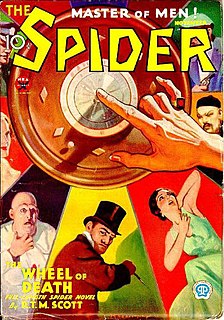
The Spider was an American pulp magazine that was published from 1933 to 1943. It included a lead novel in every issue that featured The Spider, a heroic crimefighter. It was published by Popular Publications, as a rival to Street & Smith's The Shadow and Standard Magazine's The Phantom Detective. Many of the stories involved science fiction plot devices, such as a metal-eating virus, or giant robots.

Dime Mystery Magazine was an American pulp magazine that was published from 1932 to 1950. It was the first terror fiction pulp magazine, and was the instigator of a trend in pulp fiction that came to be called weird menace fiction, in which the protagonist struggles against something that appears to be supernatural, but ultimately can be explained in everyday terms. Initially Dime Mystery contained ordinary mystery stories, but with the October 1933 issue it began publishing terror fiction. The publisher, Harry Steeger, later said he was inspired to create the new genre by the Grand Guignol theater in Paris. In 1938 it returned to detective stories once again. The stories occasionally included science fiction elements, such as robots, and drugs that can alter the flow of time. In 1950 it briefly changed its title to 15 Mystery, but ceased publication at the end of that year.
The Western Raider was an American pulp magazine. The first issue was dated August/September 1938; it was followed by two more issues under that title, publishing Western fiction, and then was changed to a crime fiction pulp for two issues, titled The Octopus and The Scorpion. Both these two issues were named after a supervillain, rather than after a hero who fights crime, as was the case with most such magazines. Norvell Page wrote the lead novels for both the crime fiction issues; the second was rewritten by Ejler Jakobsson, one of the editors, to change the character from The Octopus to The Scorpion.

The Mysterious Wu Fang was a pulp magazine which published seven issues in 1935 and 1936. Sax Rohmer's Fu Manchu, an oriental villain, was a "yellow peril" stereotype, and Popular Publications wanted to take advantage of the public's interest. The author of all seven lead novels was Robert J. Hogan, who was simultaneously writing the novels for G-8 and His Battle Aces, producing 130,000 to 150,000 words per month; Hogan was told to not to rewrite, but to deliver his first drafts. The hero of the novels was a man named Val Kildare; other characters included a young assistant to Kildare, who was probably added to attract younger readers. The artist John Richard Flanagan, who had experience illustrating Fu Manchu, was hired, but in the opinion of pulp historian Robert Weinberg, "an imitation was an imitation, and the magazine did not sell well". There were short stories along with the lead novel in each issue, also with a "yellow peril" theme; the authors included Steve Fisher, Frank Gruber, O.B. Meyers, and Frank Beaston. The magazine was cancelled after seven issues in favor of a similar magazine with a different villain: Dr. Yen Sin. According to pulp historian Joseph Lewandowski, the decision to switch titles may have been because Wu Fang was too juvenile, and Dr. Yen Sin was supposed to be more mature.

Operator #5 was a pulp magazine published between 1934 and 1939. The lead novels featured Operator #5, whose real name was Jimmy Christopher of the Secret Service. The novels were written by Frederick C. Davis until November 1935, then by Emile C. Tepperman until March 1938, and then Wayne Rogers for the remainder of the run; all three used the house name "Curtis Steele" on all their work for Operator #5. The plots always involved science fictional ideas such as revival of the dead, sonic rays that could cause panic, rays that damaged the ionosphere, and future war scenarios. Both Tepperman and Rogers embedded their novels in longer story arcs that went on for many issues, involving the invasion of America. In Tepperman's case the invading force was the Purple Empire; in Rogers' case it was the Japanese, and the sequence was unresolved when the magazine was cancelled in 1939, with the Japanese dropping atom bombs on American cities. The short stories that accompanied the lead novel were often spy stories, and included series with repeating characters such as Red Finger and John Vedders, Secret Service Agents whose adventures were chronicled by Arthur Leo Zagat and Frank Gruber, respectively.
Thrilling Mystery was an American pulp magazine published from 1935 to 1944. New York publisher Standard Magazines had a stable of magazines with the "Thrilling" prefix, including Thrilling Detective, Thrilling Love, and Thrilling Adventures, but in 1935, Popular Publications, a rival publisher, launched a weird menace pulp titled Thrilling Mysteries. Standard Magazines sued over the use of the word "Thrilling", and Popular conceded, settling out of court. Thrilling Mysteries was cancelled after a single issue, and in October 1935 Standard began Thrilling Mystery. Like Thrilling Mysteries this was a terror pulp, but it contained less sex and violence than most of the genre, and as a result, in the opinion of science fiction historian Mike Ashley, "the stories had greater originality, although they are not necessarily of better quality". Ashley singles out Carl Jacobi's "Satan's Kite", about a family cursed because of a theft from a temple in Borneo, as worthy of mention. There were two detective stories by Robert E. Howard, the creator of Conan. Other contributors included Fritz Leiber, Fredric Brown, Seabury Quinn, Robert Bloch, and Henry Kuttner. There was little science fiction in the magazine, but some fantasy: pulp historian Robert K. Jones cites Arthur J. Burks "Devils in the Dust" as "one of the most effective" stories, with "a mood as bleak as an arctic blizzard", and Ashley agrees, calling it "particularly powerful".
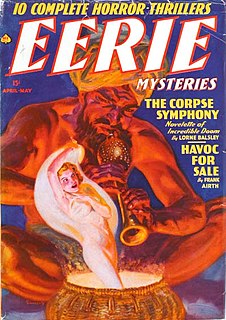
Eerie Mysteries was an American weird menace pulp magazine that published four issues in 1938 and 1939. This was Ace Magazines' third weird menace pulp, and it was no more successful than its predecessors, Ace Mystery and Eerie Stories. As with Eerie Stories, the contents were all pseudonymous, and some were reprints from Ace Mystery or Ten Detective Aces, another Ace Magazines title, where the original detective story had enough violence to be a suitable candidate. The magazine's tagline was "10 Complete Horror-Thrillers", and the reprints had their titles changed to suit the new magazine, but the new titles, such as "When It Rained Corpses" by Ralph Powers, or "Skull and Double Cross-Bones" by Eric Lennon, stressed sex less than earlier weird menace magazines had done, and pulp historian Peter Haining cites Eerie Mysteries as an example of a magazine attempting to cash in on a trend that was already starting to fade away. Haining adds that the contents were also tamer than usual: "descriptions of beautiful females being molested and tortured were notably fewer". All four covers were painted by Norman Saunders, and Haining suggests that some or all of the interior art was re-used from other Ace Magazines titles.

















